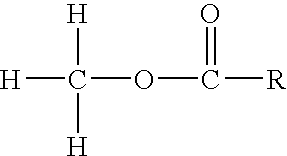Low VOC antimicrobial coating compositions
a coating composition and low-voc technology, applied in the field of improved coating compositions, can solve the problems of high cost of protective equipment such as masks and respirators, unavoidable atmospheric contamination during application and curing or drying, and high environmental stress on the environment, so as to enhance cleanability and provide resistance to microorganism growth
- Summary
- Abstract
- Description
- Claims
- Application Information
AI Technical Summary
Benefits of technology
Problems solved by technology
Method used
Image
Examples
example 1
Clear Sealer
[0030] Soy methyl esters were mixed with acrylic resin to form a clear sealer having inherent microbial resistance.
Soy Methyl Ester40%Acrylic resin20%H2O40%
[0031] Materials [0032] CSV300™ Soy Methyl Ester based emulsion sold by PCI Group, Tempe, Ariz. [0033] WorleeCryl® 8721 sold by Worlee-Chemie [0034] Tap water
[0035] Methods
[0036] An open mixing vessel equipped with a low-shear, paddle mixer was charged with clean tap water (40.0% by weight). The mixer was initially set to about 500 revolutions per minute to create a mixing vortex. Quantities of CSV3000 T emulsion (total 40.0% by weight) and WorleeCryl® 8721 Acrylic Resin (total 20.0% by weight) were added to the vortex slowly, so as not to overwhelm or close the vortex. Upon completion of the addition, the speed of the mixer was adjusted to 1000 rpm and mixing was continued for 15 minutes until the materials were homogeneous and free of discoloration of one ingredient to the other.
example 2
Alternate Clear Sealer
[0037] Soy methyl esters were mixed with acrylic resin, fungicide, preservative and algaecide to form a clear sealer having enhanced microbial resistance.
Soy Methyl Ester 37%Acrylic resin 18%Surfactant / leveling agent 0.02%biocides 0.29%preservative 0.10%thickener 0.25%H2O44.34%
[0038] Materials [0039] CSV3000™ Soy Methyl Ester based emulsion sold by PCI Group, Inc., Tempe, Ariz. [0040] WorleeCryl® 8721 sold by Worlee-Chemie WRACLA (Water Reducible Anti-cratering Leveling agent) Product #26 sold by PCI Group, Inc. [0041] Fungitrol® 720 sold by International Specialty Products [0042] Nuosept® 95 sold by International Specialty Products [0043] Nuocide® 1075 sold by International Specialty Products [0044] Rheolate 288 sold by Rheox, Inc. [0045] Clean tap water
[0046] Methods
[0047] An open mixing vessel equipped with a low-shear, paddle mixer was charged with clean tap water (37% by weight). The mixer was initially set to 100-500 paddle revolutions per minute t...
example 3
Semi-Transparent Stain
[0048] Soy methyl esters were mixed with acrylic resin, fungicide, preservative and algaecide and colorants to form a penetrating stain sealer having enhanced microbial resistance.
Soy methyl ester 37%Acrylic resin 18%Surfactant 0.02%Biocides 0.29%Preservative 0.10%Colorants 6%Thickener0.25%-1.0%H2O38.34%
[0049] Materials [0050] CSV3000™ Soy Methyl Ester based emulsion sold by PCI Group, Inc., Tempe, Ariz. [0051] WorleeCryl® 8721 sold by Worlee-Chemie WRACLA (Water Reducible Anti-cratering Leveling agent) Product #26 sold by PCI Group, Inc. [0052] Fungitrol® 720 sold by International Specialty Products [0053] Nuosept® 95 sold by International Specialty Products [0054] Nuocide® 1075 sold by International Specialty Products [0055] Color Corporation of America's 1900 Series Machine colorant yellow oxide [0056] Color Corporation of America's 1900 Series Machine colorant red oxide [0057] Color Corporation of America's 1900 Series Machine colorant burnt umber [0...
PUM
| Property | Measurement | Unit |
|---|---|---|
| Fraction | aaaaa | aaaaa |
| Fraction | aaaaa | aaaaa |
| Fraction | aaaaa | aaaaa |
Abstract
Description
Claims
Application Information
 Login to View More
Login to View More - R&D
- Intellectual Property
- Life Sciences
- Materials
- Tech Scout
- Unparalleled Data Quality
- Higher Quality Content
- 60% Fewer Hallucinations
Browse by: Latest US Patents, China's latest patents, Technical Efficacy Thesaurus, Application Domain, Technology Topic, Popular Technical Reports.
© 2025 PatSnap. All rights reserved.Legal|Privacy policy|Modern Slavery Act Transparency Statement|Sitemap|About US| Contact US: help@patsnap.com

